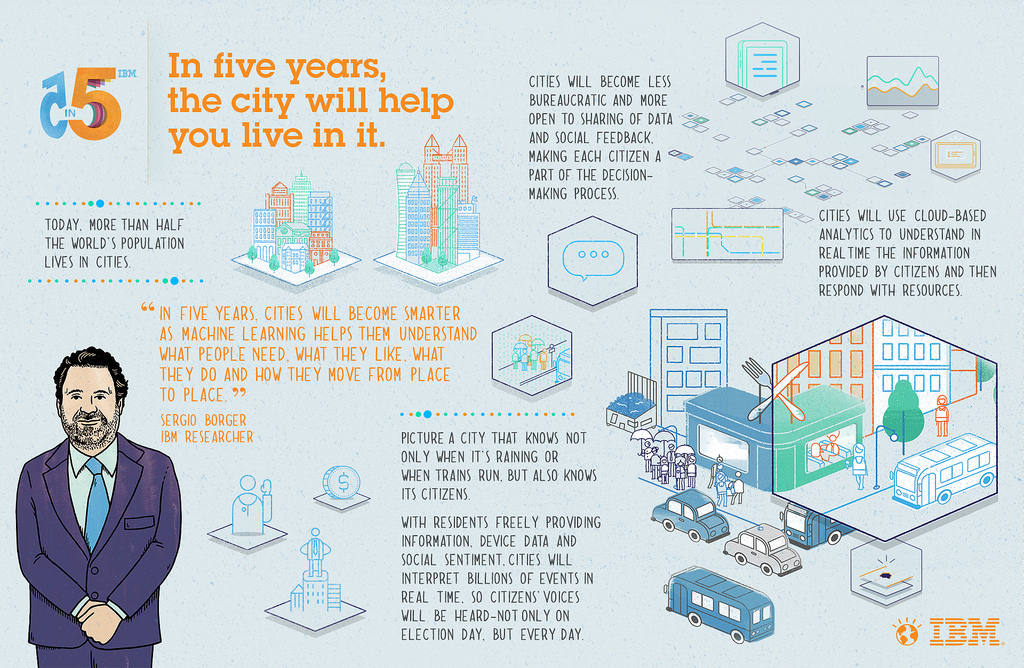Industry News Weekly Roundup
There was a lot of industry news this past week you may have missed. Here are some headlines that caught our eyes.
Do You Know What Life Will Be Like In 5 Years? IBM’s Top Scientist Does
—Fast Company
“In the 5 in 5 report IBM’s top scientists report on what the world, supported by smart sensing and computing, will look like in five years.”
Q&A: Theatre Safety in the West End
—BBC News
“After a partial collapse of the ceiling during a show at the Apollo theatre on Shaftesbury Avenue in London, West End theatre owners have reassured audiences all venues have valid safety certificates.”
Gamers Are Not Only Athletes, But the Internet Has Changed the Definition of ‘Sports’
—Wired
“A South Korean gamer just earned a visa to enter the U.S. under the category of “internationally recognized athletes.” There’s nothing unusual about that until you consider the fact that he is a videogamer, and the second this year to be awarded a visa for videogaming.”
NFL Commissioner Chose NYC as 2014 Super Bowl Site for the Money
—Skift
“…this next Super Bowl promises those in attendance something different: The chance to freeze their rear ends off.”
The Ideas that Shaped Management in 2013
—Harvard Business Review
“…we thought about the pieces that most surprised us or provoked us to think differently about an intractable problem or perennial question in management, we reviewed the whole year of data to remind ourselves what our readers found most compelling, and we looked for patterns in the subjects our authors raised most frequently and independently of our editorial urging.”
(Image: IBM/Fast Company)
Five Career Predictions for 2014
What’s going to change in your career next year compared to this year? It depends on who you ask, and there are a lot of career trends stories out there. I’ve found a good one, though, and I thought I’d share it with you.
Written by career adviser Irene Kotov for Lifehacker Australia, the “Top 10 Career Trend Predictions for 2014” are realistic and inspiring (especially if you like team work and technology). Here are five of Kotov’s predictions, along with a quote by her, that I feel stand out.
Interviews Will Get More Real
“We’ll see more of ‘roll up your sleeves and show me how you’d solve my company’s problems’ types of interviews.”
Google Will Become A Key Part Of Your Resume
“Make sure your LinkedIn profile is polished and your personal blog is full of solutions to problems in your industry, or you’ll miss out on opportunities.”
Writing For Top-Tier Blogs Will Become A Necessity
“…writing as an expert in your field on big media/industry blogs will become critical for success.”
Social Media Hotshots Will Be In Demand
“People who can create an effective social media strategy and then implement it (and demonstrate to the CEO how it drives his business goals) will be the business rockstars of 2014.”
“We” Will Begin To Gain Traction, Next To “I”
“We will see fresh new faces and companies who embrace the ‘we’ mentality at their core to create amazing workplaces, necessary products and inspiring leaders.”
Check out the rest of the article for Kotov’s other five trends, and please let us know in the comments your own career predictions for 2014.
(photo credit: HikingArtist.com via photopin cc)
Hear Ye, Hear Ye! Our Smashing Top 10 Blog Posts of 2013
Whenever you agree to be a journalist, you have to sign a contract that says you’ll post a Top 10 list every December, every year, throughout your career. It’s just one of those small sacrifices we journalists have to make so that we can bring you news and entertainment the rest of the year. So, I’m fulfilling my contractible obligations when I offer the following Top 10 list. Plus, I really enjoy finding out what posts you liked the most.
Front Row News didn’t officially begin until May, so we don’t have a full year of posts. Still, readers page viewed a lot of stories, and these are the Top 10 blog posts, the ones you really liked clicking on and reading.
- Are You Too big? Or Too Small?—Staffing Survey Report
- In Memoriam: Turner David Madden, Jr.
- Video: Join us at VenueConnect for 4 days of…
- An Editor’s Farewell
- And If You Weren’t In New Orleans, Here’s What You Missed
- Waking Up Early and Being Awoken
- Sofa vs. Stadium: Creating Great Fan Experiences
- IAVM Members Nominated for Pollstar Awards
- Top 10 Stadiums and Arenas Searches for 2013
- IAVM Files Amicus Brief to Support Industry, Member Venues
(photo credit: spatulated via photopin cc)
Lights All Night and Work All Day
My first electronic dance music experience took place in a small, warehouse space called Club Industry. Located in Deep Ellum in Dallas, the venue was like a miniature version of the raves that would become popular in the mid-1990s. As my friends and I danced to the thump thump thump of industrial techno, laser lights shot across the room and dry ice bellowed between our legs. It was our great escape from the daily grind of high school life.
Looking at today’s electronic dance music festivals, it’s easy to see that the only change is one of size. Instead of 100 people dancing in a small room, there are 100,000 dancers in a large venue or under the open sky. And with that many people, safety and security has to take a front seat in the experience.
This weekend, December 27-28, the Kay Baily Hutchinson Convention Center Dallas will play host to Lights All Night, an electronic dance music festival featuring Deadmau5, Icona Pop, and Major Lazer, among others. The event is expected to draw 40,000 guests over the two days.
Planning for the event started in January, and life safety and security was one of the first items on the agenda. To better understand what took place in those meetings, we spoke with IAVM member, Al Rojas, assistant director for the Kay Baily Hutchinson Convention Center Dallas.
“The vetting process begins with an understanding of the event logistics and timeframe,” Rojas said. “It is the same for every event. The amount of life safety and security resources will be determined by the event history in the building and other locations. Law enforcement intelligence and event activity portrayed by the media also become factors to consider.”
Rojas said the event staff looks at previous show reports and interviews with venue staff. The 2012 event was held at Dallas Fair Park and Daniel Huerta (IAVM member) and his staff were very helpful in the planning process. They also interview the event’s promoters to determine estimated attendance, arrival pattern of attendees, and the flow of attendees in the event. In addition, meetings with Dallas Police, Dallas Fire & Rescue , and event security were conducted.
“There are basic building elements to consider, such as door coverage for ingress and egress, use of vertical transportation (elevators and escalators), public space, dock access for set-up, and other occurring events,” he said.
In fact, the action plan from the 2011 event and the “After Action Reports,” from 2011 and 2012 Rojas said, became the foundation for the 2013 plan.
“All parties were at common ground, and the process was one of evaluating previous results and factoring in new logistics and current lessons learned from the event industry,” he said.
We’ll be checking in more with Rojas about Lights All Night, so please stay tuned to this blog to learn best practices from venues hosting electronic dance music events.
I’m So Excited, and I Just Can’t Hide It
One of this year’s favorite memes was the “Keep Calm and Carry On” posters, with many people replacing the “carry on” part with their own twists on the statement, such as “Keep Calm and Eat Bacon.” It appears 2013 was the year of relaxation, or at least a reminder to chill out.
Keeping calm, though, doesn’t always work. In fact, getting excited may be more beneficial if you’re suffering from performance anxiety, like public speaking or taking tests.
“Anxiety is incredibly pervasive. People have a very strong intuition that trying to calm down is the best way to cope with their anxiety, but that can be very difficult and ineffective,” said Alison Wood Brooks, Ph.D., of Harvard Business School. “When people feel anxious and try to calm down, they are thinking about all the things that could go badly. When they are excited, they are thinking about how things could go well.”
Brooks and colleagues led several experiments at Harvard University to learn more about performance and anxiety. In one experiment, participants who said “I am excited” gave longer speeches and were more persuasive, competent and relaxed than those who said “I am calm” before a speech.
“The way we talk about our feelings has a strong influence on how we actually feel,” Brooks said.
Anxiety and excitement are cut from the same sheet (high arousal), so it may be easier and more beneficial to go along with the feeling than fight it by trying to be calm.
“When you feel anxious, you’re ruminating too much and focusing on potential threats,” Brooks said. “In those circumstances, people should try to focus on the potential opportunities. It really does pay to be positive, and people should say they are excited. Even if they don’t believe it at first, saying ‘I’m excited’ out loud increases authentic feelings of excitement.”
(Image: Created on Keep Calm Studio)
Do you want to receive a Front Row News weekly digest?
Categories
- Allied (861)
- Architecture (147)
- Arenas (750)
- Career (897)
- Convention Centers (897)
- Education (623)
- Events (1,544)
- Food & Beverage (193)
- Foundation (113)
- Guest Experience (1,497)
- Industry News (2,270)
- Leadership (1,888)
- Marketing (150)
- Membership (2,001)
- Music (213)
- Performing Arts Centers (456)
- Professional Development (409)
- Research (128)
- Safety & Security (442)
- Sports (764)
- Stadiums (611)
- Student (159)
- Technology (516)
- Ticketing (92)
- Touring (82)
- Trends (365)
- Uncategorized (679)
- Universities (218)
- Video (25)
- Young Professional (198)
Twitter Feed
- Twitter feed loading
Recent Posts
- Serrano Assumes Deputy Director Position As Convention Center Expansion Progresses
- Seton Hawkins of Jazz at Lincoln Center to Deliver Keynote at VenueConnect 2025
- Where Are They Now – 30|UNDER|30 Class of 2023’s Trevor Thomas
- Time Is Running Out! Submit Your Comments on Ticketing Reform by July 7
- IAVM Announces the 2025-2026 Slate of Officers
Categories
- Allied
- Architecture
- Arenas
- Career
- Convention Centers
- Education
- Events
- Food & Beverage
- Foundation
- Guest Experience
- Industry News
- Leadership
- Marketing
- Membership
- Music
- Performing Arts Centers
- Professional Development
- Research
- Safety & Security
- Sports
- Stadiums
- Student
- Technology
- Ticketing
- Touring
- Trends
- Uncategorized
- Universities
- Video
- Young Professional
Archives
- July 2025
- June 2025
- May 2025
- April 2025
- March 2025
- February 2025
- January 2025
- December 2024
- November 2024
- October 2024
- September 2024
- August 2024
- July 2024
- June 2024
- May 2024
- April 2024
- March 2024
- February 2024
- January 2024
- December 2023
- November 2023
- October 2023
- September 2023
- August 2023
- July 2023
- June 2023
- May 2023
- April 2023
- March 2023
- February 2023
- January 2023
- December 2022
- November 2022
- October 2022
- September 2022
- August 2022
- July 2022
- June 2022
- May 2022
- April 2022
- March 2022
- February 2022
- January 2022
- December 2021
- November 2021
- October 2021
- September 2021
- August 2021
- July 2021
- June 2021
- May 2021
- April 2021
- March 2021
- February 2021
- January 2021
- December 2020
- November 2020
- October 2020
- September 2020
- August 2020
- July 2020
- June 2020
- May 2020
- April 2020
- March 2020
- February 2020
- January 2020
- December 2019
- November 2019
- October 2019
- September 2019
- August 2019
- July 2019
- June 2019
- May 2019
- April 2019
- March 2019
- February 2019
- January 2019
- December 2018
- November 2018
- October 2018
- September 2018
- August 2018
- July 2018
- June 2018
- May 2018
- April 2018
- March 2018
- February 2018
- January 2018
- December 2017
- November 2017
- October 2017
- September 2017
- August 2017
- July 2017
- June 2017
- May 2017
- April 2017
- March 2017
- February 2017
- January 2017
- December 2016
- November 2016
- October 2016
- September 2016
- August 2016
- July 2016
- June 2016
- May 2016
- April 2016
- March 2016
- February 2016
- January 2016
- December 2015
- November 2015
- October 2015
- September 2015
- August 2015
- July 2015
- June 2015
- May 2015
- April 2015
- March 2015
- February 2015
- January 2015
- December 2014
- November 2014
- October 2014
- September 2014
- August 2014
- July 2014
- June 2014
- May 2014
- April 2014
- March 2014
- February 2014
- January 2014
- December 2013
- November 2013
- October 2013
- September 2013
- August 2013
- July 2013
- June 2013
- May 2013
- April 2013
- March 2013
- February 2013
- January 2013
- May 2012
- March 2012
- December 2011
- November 2011
- October 2011
Recent Comments
- Frank Bradshaw, Ph.D., CVE on John Meyer, CVE, a Tireless Advocate of Certification for Venue Professionals, Has Died
- Neil Sulkes on Hilary Hartung, Friend to Many in Venue Marketing, Has Left Us
- Jason Parker, CVE on The Devastation of Hurricane Helene and How We Can Support One Another
- Larry Perkins on Touhey Testifies Against Speculative Ticketing Before Congressional Subcommittee
- Peter Secord on Major Players for Planned Elkhart Amphitheater Were in the Mix at VenueConnect





